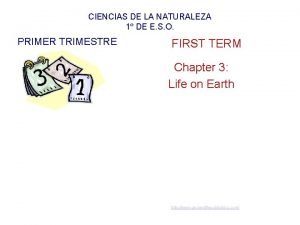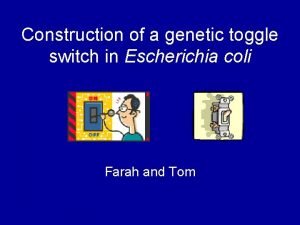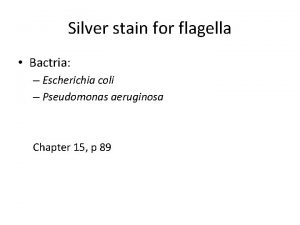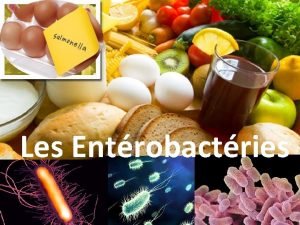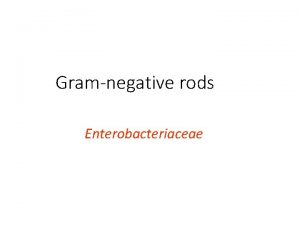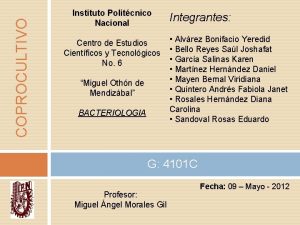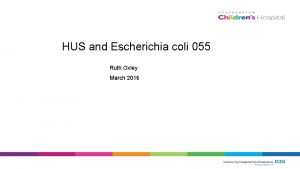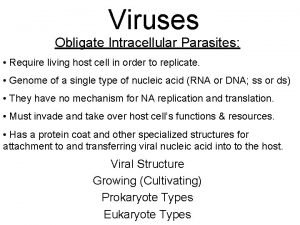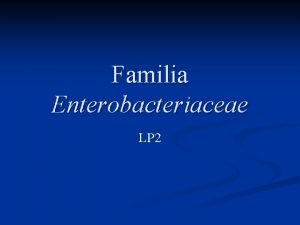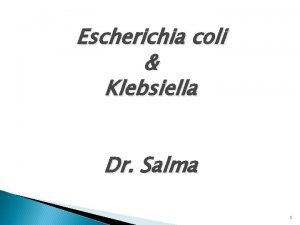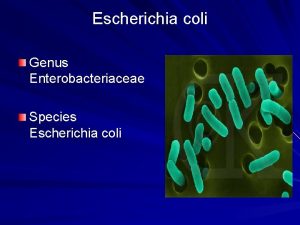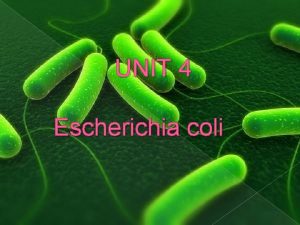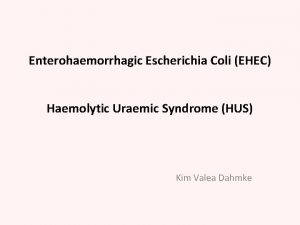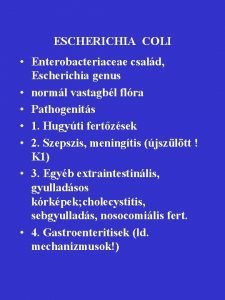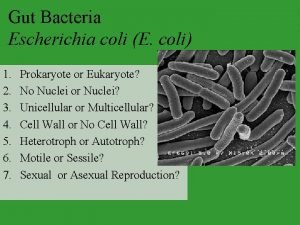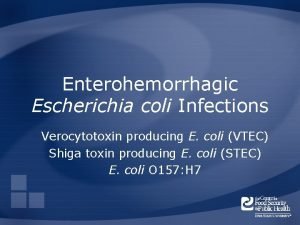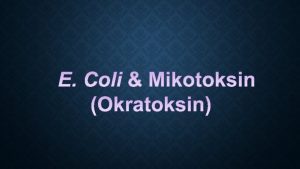HUS and Escherichia coli 055 Ruth Oxley March











- Slides: 11

HUS and Escherichia coli 055 Ruth Oxley March 2016

HUS • Haemolytic : break down of red blood cells • Uraemia : high levels of urea / waste products in the blood • Syndrome : collection of symptoms • Diagnosis is based on triad of - micro-angiopathic haemolytic anaemia - thrombocytopenia - AKI • Causes : usually 0157: H 7 E. Coli (Scheiring et al, 2010)

E. Coli • Gram negative facultative anaerobe, normally a commensal bacterium that co-exists within intestines (Tchaptchet & Hansen, 2011) • However, several E. Coli clones have acquired virulence factors that have allowed them to adapt to new niches (Farrokh, et al, 2013) • There are six catergories of pathogenic E. Coli that affect the intestines of humans (Farrokh et al, 2013)

• Shiga-toxin producing E. Coli (STEC), also called Verocytotoxic producing E. Coli (VTEC) of which enterohaemorrhagic E. Coli (EHEC) are a pathogenic sub-group • Enteropathogenic E. Coli (EPEC) • Enterotoxigenic E. Coli (ETEC) • Enteroaggregatice E. Coli (EAEC) • Enteroinvasive E. Coli (EIEC) • Diffusely adherent E. Coli (DAEC) (Farrokh et al, 2013)

• Source • Transmission • Intestines • Receptors • AKI

055 Outbreak • Over period of seven months, six children presented • All from the same geographical location • Age range 19 months to 60 months • Five had neurological involvement within 2 – 5 days of symptoms appearing • All required a PICU admission • All required PD.

055: What we know. . . • VTEC • First time it has been identified in the UK • From our limited experience, APPEARS to have a quicker and more significant neurological impact. • People can act as asymptomatic carriers – making tracing contacts more difficult.

Public Health Enquiry • HUS and VTEC are both notifiable diseases (HPA, 2011) • Outbreak control team organised • Still have not yet identified source, therefore investigations are on-going • Only thing these families had in common was geographical location • Expect to see more cases

Treatment • Same as with 0157 • Treat the symptoms until recovery • Depends on risk category of the child (HPA, 2011) • High risk groups need TWO clear samples which are taken no less than 24 hours apart, and not taken until 48 hours after last symptoms • Not in a risk group: can return back to school 48 hours after symptoms have ceased.

To consider. . • May present with a differential diagnosis • Appears to have quicker neurological impact • Impact on family can be long-term • This is a new, emerging VTEC, therefore we do not know 055 in as much detail as we know 0157. . . • Remember good hand hygiene!!

References Chart, H (2012) Escherichia In Greenwood, O. , Barer M. , Slack R. , & Ivring W. , Medical Microbiology: A guide to microbial infections, pathogenesis, immunity, laboratory investigations and control. Churchill Livingstone Elsevier. European Centre for Disease prevention and Control & European Food Safety Authority (2011) Technical Report Shiga toxin /verotoxin-producing Escherichia coli in humans, food animals in the EU/EAA, with special reference to the German outbreak strain STEC 0104. Stockholm, ECDC. Farrokh, C. , Jordan, K. , Auvray, F. , Glass, K. , Oppegaard, K et al (2013) Review of Shiga-toxin-producing Escherichia Coli (STEC) and their significance in dairy production. International Journal of Food Microbiology 162, pp 190 -212 Health Protection Agency (2011) The VTEC Operational Manual HPA, RCHPCH & RCGP (2011) The management of acute bloody diarrhoea potentially caused by vero cytotoxin-producing Escherichia coli in children. PHE (2014) The characterisitics, diagnosis, management, surveillance and epidemiology of vero-cytotoxinproducing Escherichia coli (VTEC) https: //www. gov. uk/government/collections/vero-cytotoxin-producingescherichia-coli-vtec-guidance-data-and-analysis Scheiring J, Rosales A and Zimmerhackl B. L (2010) Todays Understanding of the Haemolytic Uraemic Syndrome. European Journal of Pediatrics 169 pp 7 -13 World Health Organisation (2011) Enterohaemorrhagic Escherichia Coli (EHEC) www. who. int www. about-hus. com (accessed Jan 2016)
